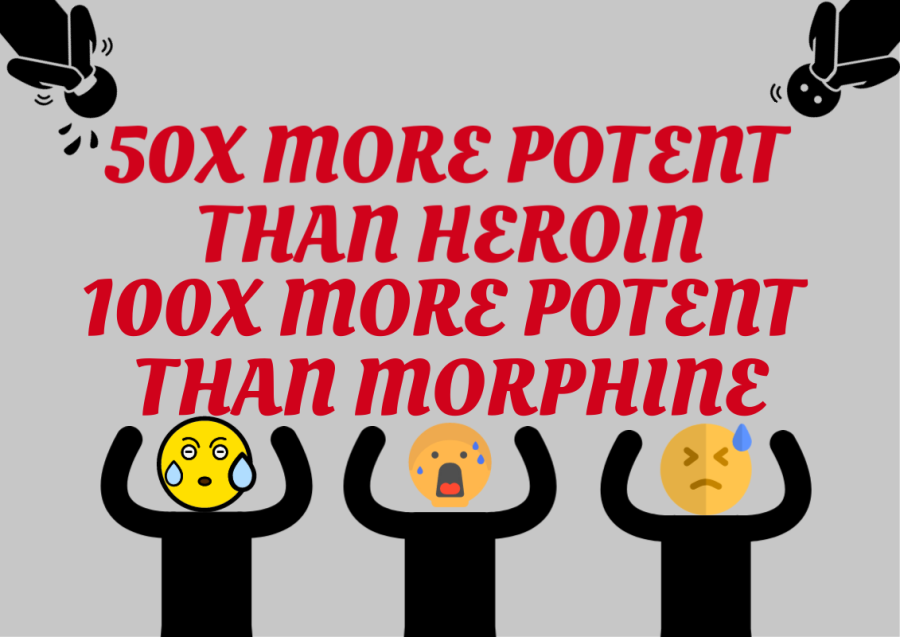Fear for Fentanyl
Opioid drugs. They have been used in the U.S. since the 1860’s, and they are widely known as painkillers. However, over thousands of years, opioid drugs have become more and more addictive, starting with the opioid flower itself in B.C. times and then transitioning all the way to cocaine in the 1990s.
However, one of the worst drugs that has come out of this opioid epidemic is fentanyl. Even though it was created in the late 1950s and was first used in the early 1960s, it has seen a massive increase in usage and overdose in the 21st century.
According to dea.gov, by definition, fentanyl is “a potent synthetic opioid drug approved by the Food and Drug Administration for use as an analgesic (pain relief) and anesthetic.” Normally, legal fentanyl is given to patients after they’ve had a surgery to help with pain, similarly to morphine (often for patients who aren’t able to take in any other synthetic opioid drugs to deal with pain).
While fentanyl can be used legally if prescribed by a doctor, most times, fentanyl comes into the United States illegally. Two different cartels in Mexico (Sinaloa and Jalisco) are the ones who are responsible for shipping illegal fentanyl. They do this by packaging fentanyl to look like different kinds of pills ranging from OxyContin to Xanax. Fentanyl, while made and shipped in Mexico, actually gets its chemicals from China, though. (dea.gov)
Fentanyl affects the brain by attaching itself to the brain’s opioid receptors. These receptors are in charge of managing peoples’ emotions and pain tolerance. The symptoms that are related to fentanyl usage range—some of these symptoms are extreme highs of happiness and others are extreme lows of depression, confusion, nausea, and sedation.
Fentanyl can be dangerous for a number of reasons. For one, it’s 50X stronger than heroin and 100X stronger than morphine. When people start to overdose on fentanyl, their breathing rate starts to slow down, and it can reach a complete stop, which is both more dangerous and more terrifying than other drugs.
Another way that fentanyl is dangerous is, as mentioned before, it can be disguised to look like other kinds of pills. More recently, fentanyl has been disguised to look like it’s candy (see 800 Podcast’s “Hurricane, Fentalyl, and Distracted Driving” podcast to learn more) to “lure young Americans,” according to a PSA that was released by the senate of West Virginia (capito.senate.gov). The PSA, calling this type of fentanyl “rainbow fentanyl,” continues by saying that “rainbow fentanyl comes in a variety of bright colors, shapes and sizes, including pills, powder and blocks that resemble sidewalk chalk.”
Rainbow fentanyl can also be laced with different synthetic drugs, which leads to another reason why fentanyl can be dangerous. Cheap fentanyl has been known to be combined with a number of other drugs, like heroin, morphine, cocaine, and MDMA in order to sell them and make a bigger profit. However, the consequence of this is that people have an even bigger chance of having an overdose with the combination of the drugs.
There are also a number of withdrawal symptoms that a person can go through if they’re addicted to fentanyl. Nida.nih.gov lists off that “muscle and bone pain, sleep problems, diarrhea and vomiting, cold flashes with goose bumps, uncontrollable leg movements, and severe cravings,” are some of the main symptoms of withdrawal caused by fentanyl. Nida.nih.gov also states that people can showcase these symptoms “as early as a few hours after the drug was last taken.”
In recent years, doctors have created medicine to help those going through opioid addictions. Three of these medicines are Naltrexone, Buprenorphine, and Methadone. It’s great to know that there are multiple ways to help those going through problems with fentanyl. There has also been some more recent good news regarding fentanyl through making it safer. According to Matthew Splett from ufhealth.org, “By applying new insights into the receptor structure, researchers designed a medication that binds to the established site of activity on the outside of the mu-opioid receptor, while also engaging a binding site for sodium ions that exists deep within the receptor.” This means that scientists are starting to create a medicine that can continue to provide pain relief while also reducing the negative symptoms that come with fentanyl.




